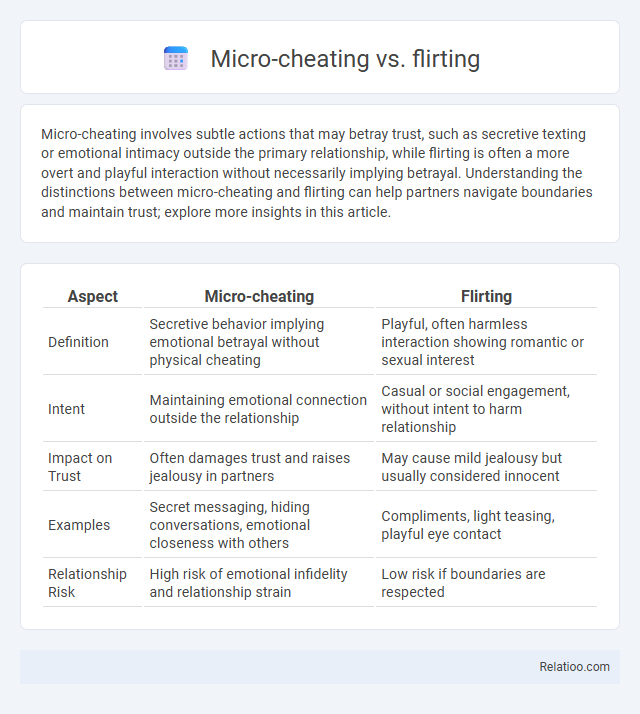Micro-cheating involves subtle actions that may betray trust, such as secretive texting or emotional intimacy outside the primary relationship, while flirting is often a more overt and playful interaction without necessarily implying betrayal. Understanding the distinctions between micro-cheating and flirting can help partners navigate boundaries and maintain trust; explore more insights in this article.
Table of Comparison
| Aspect | Micro-cheating | Flirting |
|---|---|---|
| Definition | Secretive behavior implying emotional betrayal without physical cheating | Playful, often harmless interaction showing romantic or sexual interest |
| Intent | Maintaining emotional connection outside the relationship | Casual or social engagement, without intent to harm relationship |
| Impact on Trust | Often damages trust and raises jealousy in partners | May cause mild jealousy but usually considered innocent |
| Examples | Secret messaging, hiding conversations, emotional closeness with others | Compliments, light teasing, playful eye contact |
| Relationship Risk | High risk of emotional infidelity and relationship strain | Low risk if boundaries are respected |
Understanding Micro-Cheating: Definition and Examples
Micro-cheating involves small, secretive actions that suggest emotional or physical interest outside your committed relationship, such as frequent texting with a potential love interest or hiding interactions on social media. Unlike flirting, which can be playful and harmless, micro-cheating crosses boundaries by fostering intimacy that undermines trust without overtly cheating. Recognizing micro-cheating behaviors helps you safeguard emotional fidelity by setting clear boundaries and maintaining transparency with your partner.
What Constitutes Flirting? Key Behaviors Explained
Flirting involves playful, often ambiguous behaviors like sustained eye contact, teasing, compliments, and light physical touch that signal romantic or sexual interest without explicit commitment. Key behaviors include engaging in personal conversations, smiling frequently, and using body language that suggests attraction or intimacy. Understanding these signs helps you distinguish harmless interactions from micro-cheating, which crosses boundaries through secretive or emotionally intimate acts outside a committed relationship.
Micro-Cheating vs Flirting: Core Differences
Micro-cheating involves subtle actions that suggest emotional or physical intimacy outside your committed relationship, often blurring boundaries and causing trust issues. Flirting is typically a light, playful interaction without intent to deepen emotional connections or betray your partner's trust. Understanding these core differences helps you recognize when harmless behavior crosses into micro-cheating, potentially harming your relationship.
Common Signs of Micro-Cheating in Modern Relationships
Micro-cheating manifests through subtle behaviors like secretive texting, emotional intimacy with someone outside the relationship, and hiding interactions on social media, which often blur boundaries without overt infidelity. Flirting generally involves playful or romantic gestures that may be innocent or intended, whereas micro-cheating includes actions that betray trust and create emotional distance. Your awareness of these common signs helps maintain transparency and trust, preventing small breaches from escalating into larger relationship issues.
Flirting: Innocent Fun or Emotional Threat?
Flirting often walks a fine line between innocent fun and an emotional threat, depending on intention and context. While micro-cheating involves subtle behaviors hinting at emotional infidelity, flirting can sometimes blur boundaries, causing partner insecurity. Understanding the nuances helps distinguish harmless social interaction from actions that potentially damage trust in relationships.
Why Micro-Cheating Often Goes Unnoticed
Micro-cheating often goes unnoticed because it involves subtle behaviors like secretive texting or emotional intimacy that don't meet the traditional boundaries of cheating but still betray trust. Unlike overt flirting or explicit infidelity, these small actions are easily rationalized or dismissed, making them harder for partners to detect or confront. The ambiguity in defining micro-cheating allows individuals to mask it as harmless interaction, blurring the lines between harmless socializing and emotional betrayal.
The Role of Social Media in Micro-Cheating and Flirting
Social media platforms drive the blurred lines between micro-cheating and flirting by enabling subtle interactions like liking posts, commenting, or private messaging that can spark jealousy or suspicion. Your digital presence on apps like Instagram, Snapchat, or TikTok intensifies micro-cheating behaviors as these actions are often hidden yet emotionally charged. Understanding how social media fosters constant connectivity and ambiguous communication helps clarify the distinctions between playful flirting and micro-cheating's emotional betrayal.
Emotional Consequences: Impact on Trust and Intimacy
Micro-cheating involves subtle behaviors like secretive texting or emotional secrecy that erode trust and create emotional distance, while flirting, often perceived as harmless, can still trigger jealousy and insecurity in committed relationships. Both micro-cheating and flirting undermine emotional intimacy by fostering doubt and reducing openness between partners. The emotional consequences of these behaviors include heightened anxiety, decreased trust, and potential long-term damage to relationship stability.
Setting Boundaries: Healthy Relationship Communication
Setting boundaries is essential for distinguishing micro-cheating from flirting, ensuring clear and respectful communication within your relationship. Defining acceptable behaviors helps prevent misunderstandings and fosters trust between partners. Open dialogue about limits and feelings creates a safe space for addressing concerns and maintaining emotional well-being.
Navigating Gray Areas: When Does Flirting Become Cheating?
Navigating the gray areas between micro-cheating and flirting requires understanding intent and boundaries, as micro-cheating involves subtle signs of emotional or physical infidelity that can erode trust without overt actions. Flirting becomes cheating when it crosses the line into secrecy, emotional intimacy, or physical contact that betrays your partner's expectations and commitment. Recognizing these nuances helps you protect your relationship by setting clear limits on your interactions and maintaining open communication.

Infographic: Micro-cheating vs Flirting
 relatioo.com
relatioo.com